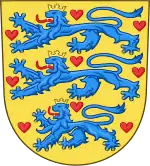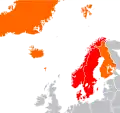Folketing
The Folketing (Danish: Folketinget, pronounced [ˈfʌlkəˌtsʰe̝ŋˀð̩]; lit. the people's thing, people's assembly), also known as the Danish Parliament in English,[4] is the unicameral national legislature (parliament) of the Kingdom of Denmark—Denmark proper together with the Faroe Islands and Greenland. Established in 1849, until 1953 the Folketing was the lower house of a bicameral parliament, called the Rigsdag; the upper house was Landstinget. It meets in Christiansborg Palace, on the islet of Slotsholmen in central Copenhagen.
Danish Parliament Folketinget | |
|---|---|
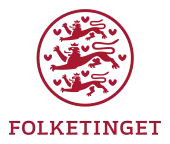 | |
| Type | |
| Type | |
| Leadership | |
Deputy Speakers | |
| Structure | |
| Seats | 179 |
 | |
Political groups | Government (49)
Supported by (46)
Opposition (84)
|
| Elections | |
| Open list proportional representation with a 2% election threshold | |
Last election | 5 June 2019 |
Next election | On or before 4 June 2023 |
| Meeting place | |
 | |
| Folketingssalen, Christiansborg Palace, Copenhagen | |
| Website | |
| www | |
 |
|---|
| This article is part of a series on the politics and government of Denmark |
|
|
The Folketing passes all laws, approves the cabinet, and supervises the work of the government. It is also responsible for adopting the state's budgets and approving the state's accounts. As set out in the Danish Constitution, the Folketing shares power with the reigning monarch. In practice, however, the monarch's role is limited to signing laws passed by the legislature; this must be done within 30 days of adoption.
The Folketing consists of 179 representatives; including two from Greenland and a further two from the Faroe Islands. General elections must be held every four years, but it is within the powers of the Prime Minister to ask the monarch to call for an election before the term has elapsed. On a vote of no confidence, the Folketing may force a single Minister or the entire government to resign.[5]
Members are democratically elected by proportional representation: 135 in districts using the D'Hondt method and with 40 leveling seats. The Danish political system has traditionally generated coalitions. Most post-war governments have been minority coalitions ruling with the support of non-government parties.[6] The first sitting of the house is usually attended by Queen Margrethe II.[7]
History
From 1849 to 1953 the Folketing was one of the two houses in the bicameral parliament known as the Rigsdag; the other house was known as Landstinget. Since both houses, in principle, had equal power, the terms "upper house" and "lower house" were not generally used. The difference between the houses was voter representation.
The Folketing was elected by common vote among men and consisted mainly of independent farmers, traders, and merchants as well as the educated classes. From 1866 to 1915 the right of vote for the Landsting was restricted to the wealthiest, and some of its members were appointed by the king, thus it predominantly represented the landed gentry and other conservatives. From 1915 both men and women had the right of vote for both houses, and also the Landsting was elected by common vote, although indirectly and with a higher age limit than for the Folketing. During the next decades, law-making mainly took place in the Folketing and the Landsting came to be regarded as a superfluous rubber stamp.

In 1953, a revised constitution was adopted by popular vote. Among the changes was the elimination of the Landsting and the introduction of a unicameral parliament, known only as the Folketing. Christiansborg Palace (also known by its nickname Borgen, Danish for the castle) has been the domicile of parliament since 1849. The palace is located in the heart of Copenhagen.
Gaining representation in parliament requires only 2% of the vote. With such a low election threshold, a large number of parties are represented in the chamber, making it all but impossible for one party to win the 90 seats necessary for a majority. No party has achieved this since 1901. All Danish governments since then have been coalitions or one-party minority governments. For this reason, a long-standing provision in the constitution allows a government to take office without getting a vote of confidence and stay in office as long as it does not lose a vote of no confidence. One consequence is that, unlike in most other parliamentary systems, a Danish government can never be sure its legislative agenda will pass, and it must assemble a majority for each individual piece of legislation.
Constitutional requirements
| Wikisource has original text related to this article: |
- Composition of members
- The Folketing consists of 179 members all elected for a four-year term or until the Prime Minister (via the Queen-in-council) calls for elections, whichever comes first. 175 members are elected in Denmark proper, while Greenland and the Faroe Islands each elect two members separately.
- The constitution does not mention political parties at all, although the electoral act does, and MPs are almost always elected for a party. The only independent who has been elected in modern times is the comedian Jacob Haugaard, but independents, usually unknown ones, are seen at every election. Requirements for standing as an independent candidate are much more lenient than for a new party (signatures from 150 eligible voters), but independents are only allowed to contest in a single district, making it very difficult to gain the needed number of votes for a seat.
- Voting system
- The Constitution requires for "equal representation of the various opinions of the electorate", and for regional representation to be secured. The electoral act stipulates the details for this (for the Denmark seats): 135 seats are elected by proportional representation in 10 districts, and 40 supplementary seats are allotted to make out for the difference between district and nationwide vote. The 135 seats are distributed to the parties by the D'Hondt method of the party-list system of proportional representation and the 40 supplementary seats by the Sainte-Laguë method. Each party may choose among a number of methods for how the seats won by that party are to be distributed among the candidates.[8]
- The result is proportional representation; however, in rare cases, the biggest parties may gain one or two seats extra from smaller parties.
- The voter may vote for a party list, one of the candidates on a party list, or an independent candidate.
- Parties (usually district party assemblies) decide on the nomination of candidates before the election. When co-nomination is assigned, candidates are elected according to personal votes. When priority order is assigned, only an extreme number of personal votes can change the rank.
- Parties must either pass the threshold, 2% of the national vote, or gain a district seat to gain any supplemental seats. Though very rare, it is possible for a party to gain a district seat without getting 2% of the national vote. There is also an esoteric third rule that allows a party to be represented, if it has enough votes in two of the three areas that the country is divided into. No party has ever fulfilled this rule without getting 2% of the national vote.
- To stand for election, parties that are not currently represented in Parliament must collect certificates of support from approximately 20,000 voters (the number of valid votes cast in Denmark proper at the latest election, divided by 175—the equivalent of one seat; after the 2007 election the required number is 19,769) and have these individually stamped by the registration office in these voters' municipalities of residence.
- Voter requirements
- Denmark has universal suffrage for all citizens over 18 years who live in the realm and who have not been declared incapable of managing their own affairs. The constitution makes it possible to restrict suffrage for convicted criminals and people receiving social benefits, but this option has not been used for several decades.
- All voters who have not been convicted of criminal acts that makes them unworthy for a seat in the parliament, are eligible. The Folketing decides if a member is eligible or not (after his election).
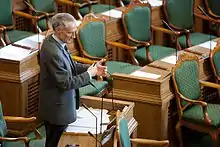
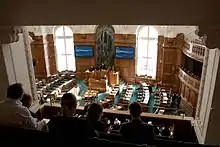
- Parliamentary privileges
- Members enjoy immunity, meaning that no criminal charges may be brought against an MP, unless he is caught red-handed, provided that the Folketing does not lift the immunity. The purpose of this is to prevent political persecution. In practice, the Folketing has always lifted the immunity when a member has been accused of a crime, usually with the consent of the accused member himself.[9]
- Debates can be conducted behind closed doors, although this has not happened since 9 April 1940, day of the German invasion in WW II.
- Ministers
- Ministers may hold a seat in parliament, but they do not need to. Supreme Court judges—according to convention—may not hold a seat whilst also acting as judges.
- Ministers may—even if they are not MPs—demand talking time whenever they want.
- Legislating
- Bills may be brought before parliament by members (private member's bills) and ministers. Bills are predominantly brought before parliament by ministers, because they have the Law Office of the Ministry of Justice at their disposal. Instead of putting forward a private bill, the opposition usually put forward a proposal for parliamentary decision, i.e., a short resolution that addresses the subject and directs the relevant minister to propose a bill concerning it.
Forming a parliament
The 179 members of the folketing are directly elected to four-year terms, subject to calls for early elections. All Danish citizens 18 years or older may vote in legislative elections, which are conducted by secret ballot. Folketing seats are allocated among the various parties using the D'Hondt method of party list proportional representation. A party or electoral alliance must pass the election threshold of 2% of the overall vote to be allocated a seat.
Coalition governments
The Danish political system is characterised by a fusion of powers, with the government being drawn from the ranks of the Folketing. Denmark is governed by a Cabinet and a Prime Minister commanding a majority in the Folketing. In order to command a majority and pass laws, the Prime Minister must form alliances with parties outside government, as well as multiple parties within a coalition Cabinet.
During his first term, Lars Løkke Rasmussen, led a centre-right minority government consisting of the Liberal Party (Venstre) and the Conservative People's Party. This coalition government worked with regular parliamentary support from the national conservative Danish People's Party and often gained the necessary 90th seat for majority in the Folketing through negotiations with either the sole MP from the Christian Democrats, Ørum-Jørgensen[10] or another MP outside parties, Christmas Møller, both elected in 2007 as conservative MPs and having defected since then.
Since the 2007 elections, the Liberal Alliance (previously Ny Alliance) have gained momentum in opinion polls, and since early 2010, the governing coalition have not been able to gather a majority in the polls without the support of the Alliance. The continuing rise in the polls is to an extent the result of the internal crisis in the Conservative People's Party over the leadership Lene Espersen[11] and the continuing debate over a lack of "true" liberal/conservative ideology in government policy.[12]
On 13 January 2011, the continuing turmoil within the Conservative group in the Folketing caused Lene Espersen to resign as political leader of the party and focus on her role as Minister of Foreign Affairs.[13] A leadership election between Brian Mikkelsen, the Minister of Economic and Business Affairs and Lars Barfoed, the Justice Minister, was widely expected,[14] but on 14 January the Conservative group in the Folketing unanimously elected Barfoed as their new political leader.[15]
The Social Democrats under the leadership of Helle Thorning-Schmidt have enjoyed continuing majorities in opinion polls since late 2009 and hopes to form a centre-left government coalition consisting of the Socialist People's Party and the Social Liberal Party with parliamentary support from the small Red-Green Alliance.[16][17]
Both Margrethe Vestager (Social Liberal Party) and Villy Søvndal (Socialist People's Party) pledged their support to Thorning-Schmidt before the 2011 election.[18] But there has been considerable debate about the future politics of this coalition, mainly because the Social Liberal Party demands a more liberal economic agenda. Also on immigration issues there are political differences between the three coalition parties. This has led some observers to believe that the Social Liberal Party will not join a government coalition but instead opt to be a part of the parliamentary support of a new, centre-left government.[19] In the event the Social Liberals did join the new three-party coalition government formed on 3 October.
Following the 2015 general election, Thorning-Schmidt was replaced as Prime Minister by her predecessor Lars Løkke Rasmussen. Until 28 November 2016,[20] he led a government consisting only of Venstre — a very unusual situation in Danish politics.
Speaker
The Speaker is the presiding officer of the Folketing. The Speaker determines which members may speak, and is responsible for maintaining order during debates. The position was created in 1850, and the inaugural holder of the office was Carl Christoffer Georg Andræ. The current Speaker is Henrik Dam Kristensen of the Social Democrats.[21] The Speaker and four Deputy Speakers are elected by MPs at the opening of parliament after each general election and compose presidium of the body.[22]
| Position | Member | Party |
|---|---|---|
| President | Henrik Dam Kristensen | Social Democrats |
| First Deputy Speaker | Karen Ellemann | Venstre |
| Second Deputy Speaker | Pia Kjærsgaard | Danish People's Party |
| Third Deputy Speaker | Jens Rohde | Social Liberal Party |
| Fourth Deputy Speaker | Trine Torp | Socialist People's Party |
Composition
Historical composition
Between 1918 and 1920 the Folketing had 140 seats, this was then increased to 149. The number was increased to 179 in 1953, which it remains to this day.
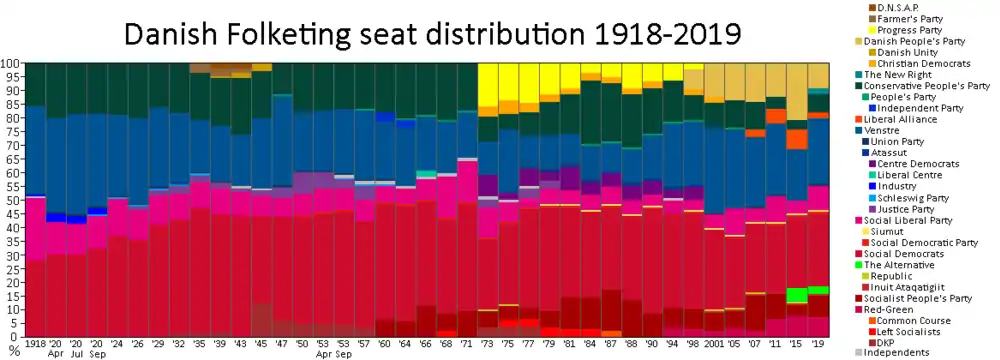
Current composition
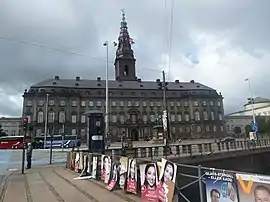
 |
|---|
| This article is part of a series on the politics and government of Denmark |
|
|
See also
- Constituencies in Denmark
- Løgting – Faroe Islands (Parliament)
- Inatsisartut – Greenland (Parliament)
- Cabinet of Denmark
- List of Prime Ministers of Denmark
- Elections in Greenland
- Elections in the Faroe Islands
Notes
- Faroese and Greenlandic political parties represented in the Danish parliament.[1]
References
- "Her er rød bloks breve til dronningen". nyheder.tv2.dk. 6 June 2019.
- "Frafaldne Alternativet-medlemmer stifter nyt parti". nyheder.tv2.dk. 4 September 2020.
- "Uffe Elbæk melder sig ud af Alternativet". altinget.dk. 9 March 2020.
- "About the Danish Parliament". thedanishparliament.dk. The Danish Parliament. Archived from the original on 25 August 2015. Retrieved 23 August 2015.
- "A Minister shall not remain in office after the Parliament has passed a vote of no confidence in him." The Constitution of Denmark – Section 15.
- "Radikale ved historisk skillevej". Berlingske Tidende. 17 June 2007. Retrieved 17 August 2007.
- "The Danish Parliament opens on 6 October". thedanishparliament.dk. Folketinget (The Danish Parliament). Archived from the original on 28 April 2016. Retrieved 13 April 2016.
- (in Danish)
- "Fakta om ophævelse af parlamentarisk immunitet" [Facts about lifting parliamentary immunity] (in Danish). DR. 23 May 2003. Retrieved 8 August 2017.
- "Kristendemokraterne vil med i finansloven". Politiken.dk (in Danish). 26 July 2011. Archived from the original on 11 January 2012. Retrieved 16 September 2011.
- "Lene Espersens krise smitter af på Løkke – Politiko | www.b.dk". Berlingske.dk. Archived from the original on 22 July 2012. Retrieved 16 September 2011.
- Af Uffe Tang og Christian Brøndum. "Liberal Alliance redder regeringen – Politiko | www.b.dk". Berlingske.dk. Archived from the original on 25 December 2010. Retrieved 16 September 2011.
- Af Lene Frøslev. ""Det er den rigtige beslutning" – Politiko | www.b.dk". Berlingske.dk. Retrieved 16 September 2011.
- Af Morten Henriksen og Chris Kjær Jessen. "Både Barfoed og Brian vil afløse Lene – Politiko | www.b.dk". Berlingske.dk. Archived from the original on 16 January 2011. Retrieved 16 September 2011.
- Af Louise Lyck Dreehsen. "Barfoed taler til pressen – Politiko | www.b.dk". Berlingske.dk. Retrieved 16 September 2011.
- "Rød dominans – Politik". BT.dk. 13 June 2010. Retrieved 16 September 2011.
- "Greens: Markant rødt flertal – dr.dk/Nyheder/Politik". Dr.dk. Retrieved 16 September 2011.
- "Vestager peger på Helle Thorning". Borsen.dk. 20 October 2008. Retrieved 16 September 2011.
- "Radikale med i regering – hvis ... – dr.dk/Nyheder/Politik". Dr.dk. 19 August 2010. Retrieved 16 September 2011.
- "Denmark PM strikes deal to form new government". dw.com. Retrieved 13 February 2017.
- Mansø, Rikke Gjøl (20 June 2019). "Henrik Dam Kristensen bliver Folketingets næste formand". DR (in Danish). Retrieved 21 June 2019.
- "The Speaker". Thedanishparliament.dk. Archived from the original on 25 August 2015. Retrieved 23 August 2015.
External links
- Official website (in English)
 Media related to Folketinget at Wikimedia Commons
Media related to Folketinget at Wikimedia Commons- The Danish Parliament at Google Cultural Institute
